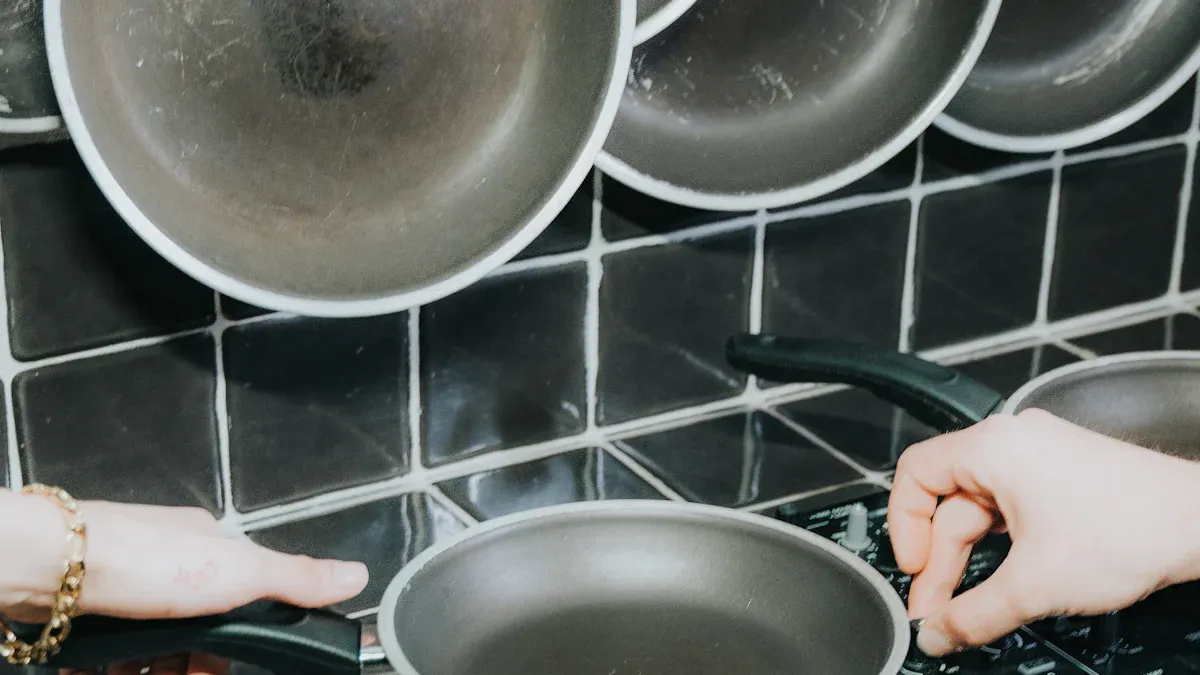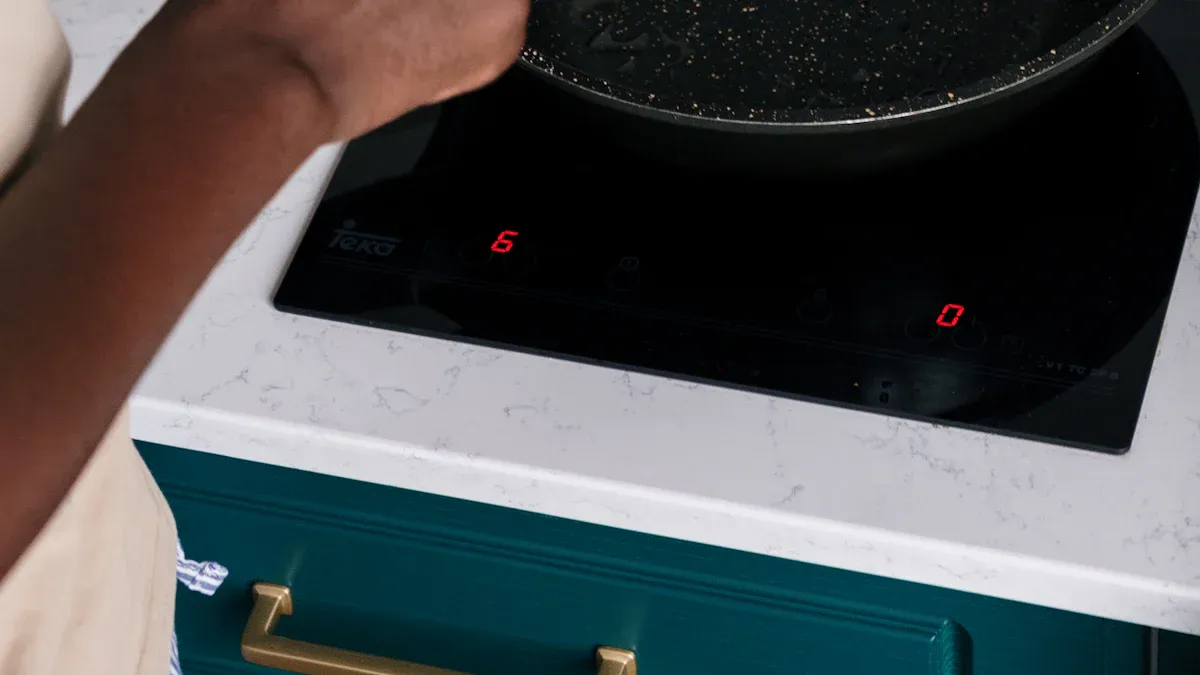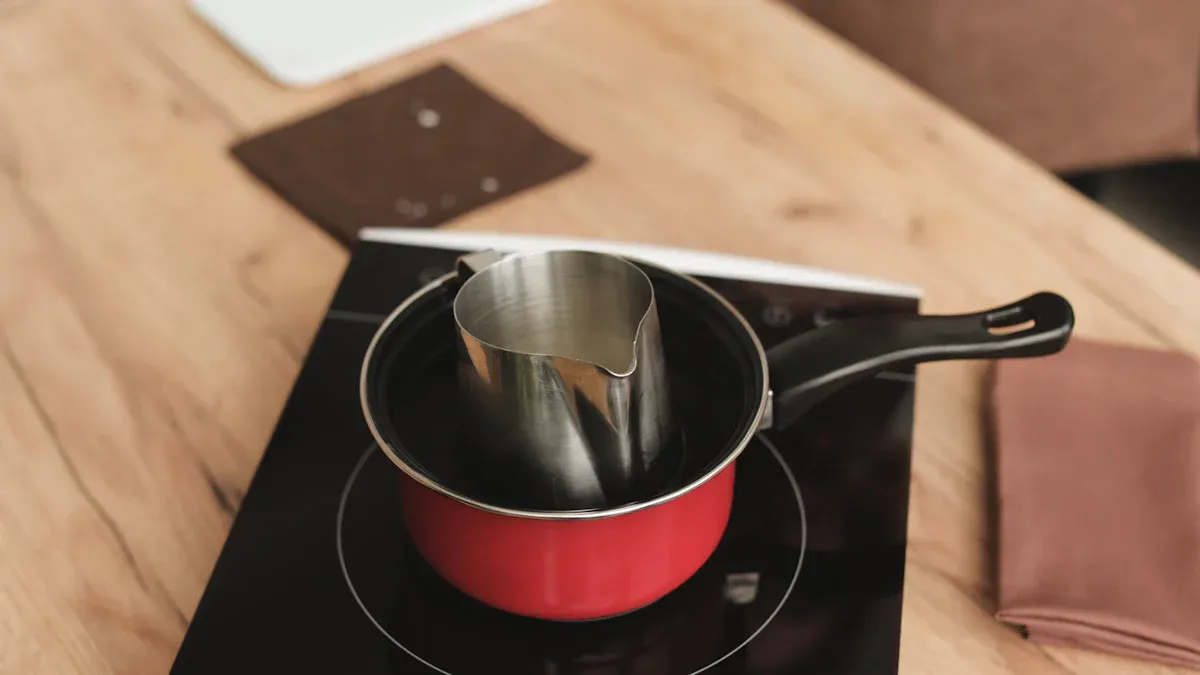
You want the best cooking on your induction hob. Dedicated induction cookware gives you much better results. This happens because it transfers heat directly, works very efficiently, and cooks consistently. An induction disk plate cannot match this performance. For optimal cooking, induction cookware is the clear superior choice.
Key Takeaways
- Induction cookware heats food directly and quickly. It uses less energy and gives you better control over cooking.
- An induction disk plate heats food indirectly. It wastes energy, cooks slowly, and makes temperature control difficult.
- For the best cooking results and safety, always choose cookware made for induction cooktops.
Understanding Induction Technology Basics

You might wonder how an induction cooktop works its magic. It does not use traditional heat sources like gas flames or electric coils. Instead, it uses a clever scientific principle to cook your food.
How Induction Cooktops Generate Heat
An induction cooktop creates an electromagnetic field. This field passes through the cooking surface. When you place a compatible pot or pan on the hob, this field causes tiny electrical currents to flow directly within the cookware itself. These currents are called eddy currents. The resistance of the pot’s material to these currents generates heat. This means your cookware becomes the heat source, not the cooktop. The cooktop surface stays cool to the touch, making it very safe. You get fast, precise heat right where you need it.
The Role of Ferromagnetic Materials
Induction cooking relies on a special type of material: ferromagnetic metals. Not all metals work with induction. Ferromagnetic materials have magnetic properties. They can interact with the electromagnetic field produced by the cooktop. Cast iron and many types of stainless steel are ferromagnetic. Aluminum or copper cookware will not work on an induction hob unless they have a special ferromagnetic base. You can test your cookware with a magnet. If a magnet sticks firmly to the bottom, your pot or pan is ready for induction cooking. This magnetic property is essential for the eddy currents to form and generate heat.
Induction Cookware: The Direct Heating Advantage

You get the best cooking experience with cookware designed for induction. This type of cookware works directly with your hob.
What Makes Cookware Induction-Compatible
You need cookware made from ferromagnetic materials. These materials attract magnets. Cast iron and many stainless steel pots and pans are good examples. Some aluminum or copper pans have a special magnetic induction base. This base allows them to work on an induction hob. You can easily check your existing pots. Just hold a magnet to the bottom. If the magnet sticks firmly, your cookware is induction-compatible. This magnetic property is crucial for the induction process.
Benefits of Direct Induction Cookware
Dedicated induction cookware offers many advantages. You experience very fast heating times. The heat goes directly into your food, not into the air. This makes cooking more energy-efficient. You also get precise temperature control. The hob responds instantly to your adjustments. This means you can quickly change heat levels. Your food cooks evenly because the heat spreads well through the pan. This direct heating method gives you superior cooking results every time.
Considerations for Induction Cookware
When you choose induction cookware, keep a few things in mind. Always pick pans with a flat, smooth bottom. This ensures maximum contact with the hob. A flat bottom helps with efficient heat transfer. You should also consider the material quality. Good quality cookware lasts longer and performs better. Make sure the pan size matches your hob’s cooking zones. This helps optimize heating and efficiency. Investing in good induction cookware improves your cooking.
Induction Disk Plates: The Indirect Heating Method
How an Induction Disk Plate Works
You might own cookware that does not work on your induction hob. An induction disk plate provides a workaround. You place this special metal plate directly onto your induction cooktop. The cooktop’s electromagnetic field heats the disk plate itself. This plate then gets very hot. You then set your non-induction pot or pan on top of the hot disk plate. The heat moves from the plate to your cookware. This method is indirect. Your pot or pan does not directly respond to the induction field.
Initial Appeal of an Induction Disk Plate
An induction disk plate often looks like a good idea at first. You can continue using your favorite non-induction pots and pans. This means you avoid buying a whole new set of cookware. It offers a way to adapt your existing kitchen tools. Many people consider it a cost-effective solution. You can keep using your cherished copper, aluminum, or glass pans without replacing them.
Inherent Drawbacks of an Induction Disk Plate
However, an induction disk plate comes with significant disadvantages. You lose a lot of energy during the process. The heat must travel from the hob, through the disk, and then finally to your pan. This makes cooking much slower than direct induction. You also get less precise temperature control. The disk itself becomes extremely hot, creating a burn risk. This indirect heating can also cause uneven heat distribution on your cooktop. This might even lead to damage to your hob over time. You also find cleaning the extra disk an added chore.
Performance Comparison: Induction Cookware vs. Induction Disk Plate
You want to understand how these two options truly perform. Let’s look at key aspects. You will see clear differences in efficiency, speed, control, and safety.
Energy Efficiency and Heat Transfer
Dedicated induction cookware offers superior energy efficiency. The electromagnetic field directly heats the base of your pot or pan. This means very little energy escapes into the air. Almost all the heat goes straight into your food. You save energy and cook faster.
An induction disk plate works differently. You place the disk on the hob. The hob heats the disk. Then, the disk heats your non-induction pan. This process involves two heating steps. Each step loses some energy. A lot of heat escapes into the kitchen air. This makes cooking less efficient. You use more electricity to achieve the same cooking temperature.
Speed and Responsiveness in Cooking
Induction cookware provides incredible speed. Your pan heats up almost instantly. When you adjust the power setting, the heat changes immediately. This quick response gives you precise control over your cooking. You can boil water in minutes. You can quickly reduce a simmer.
An induction disk plate slows everything down. The disk itself needs time to heat up. Then, your pan needs time to absorb heat from the disk. This creates a significant delay. When you change the hob’s setting, the heat transfer to your pan is not immediate. You lose the instant responsiveness that induction cooking offers.
Temperature Control and Consistency
You get excellent temperature control with induction cookware. The heat spreads evenly across the bottom of your pan. This prevents hot spots. You can maintain a steady temperature for delicate sauces or precise searing. Your food cooks consistently.
An induction disk plate struggles with temperature control. The disk often heats unevenly. This creates hot spots on the disk. Your pan then receives uneven heat. You might find parts of your food burning while other parts remain undercooked. It is very hard to maintain a consistent temperature. The indirect heating makes fine adjustments difficult.
Durability and Longevity Concerns
Induction cookware is built for direct induction heat. It withstands repeated heating and cooling cycles well. Good quality induction pans last a long time. They maintain their flat bottoms and efficient heating properties.
An induction disk plate faces extreme stress. It gets very hot. It then transfers this heat to your pan. This constant high heat can cause the disk to warp or discolor over time. The disk’s material can degrade. This reduces its effectiveness. It can also put extra stress on your induction cooktop itself. The cooktop works harder to heat the disk. This might shorten the cooktop’s lifespan.
Safety Implications of an Induction Disk Plate
Safety is a major benefit of induction cooking. With induction cookware, the cooktop surface stays relatively cool. Only the pan gets hot. This reduces the risk of accidental burns.
An induction disk plate introduces significant safety concerns. The disk itself becomes extremely hot. It stays hot for a long time after you turn off the hob. You can easily burn yourself if you touch it. The hot disk also radiates heat into the surrounding area. This can make your kitchen hotter. You also have a very hot object sitting on your cooktop. This increases the risk of burns or other accidents.
FAQ
Can I use any pot with an induction disk plate?
You can use non-induction pots like aluminum, copper, or glass. The disk heats these pans indirectly.
Does an induction disk plate save energy?
No, an induction disk plate uses more energy. Heat transfers indirectly. This causes significant energy loss.
Is an induction disk plate safe to use?
An induction disk plate gets very hot. It stays hot for a long time. This increases the risk of burns.
Post time: Nov-26-2025
